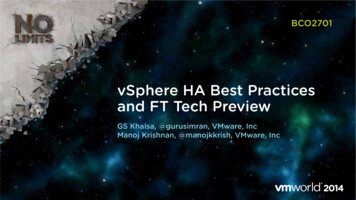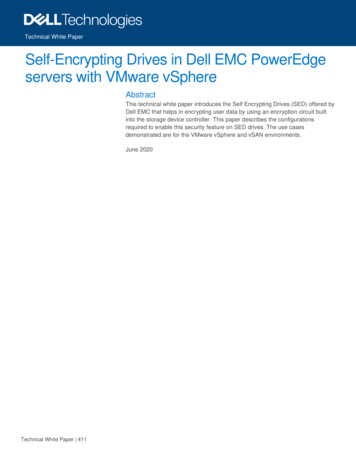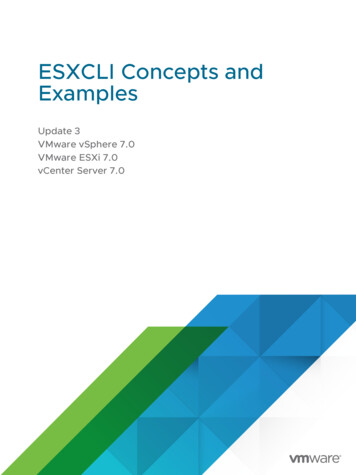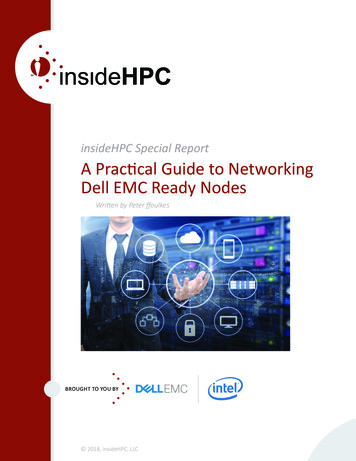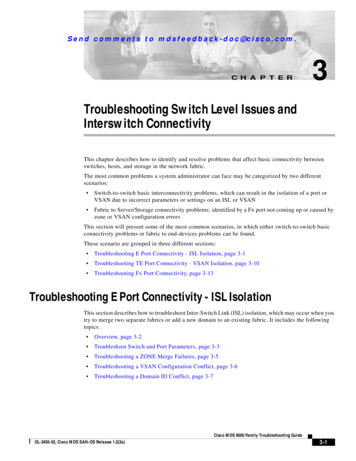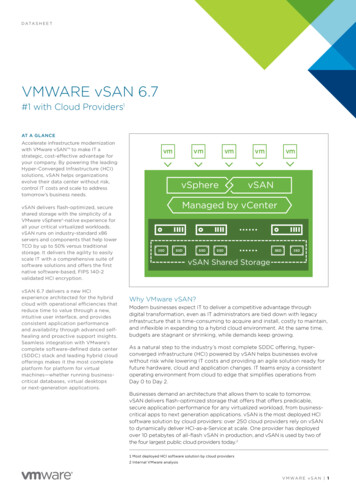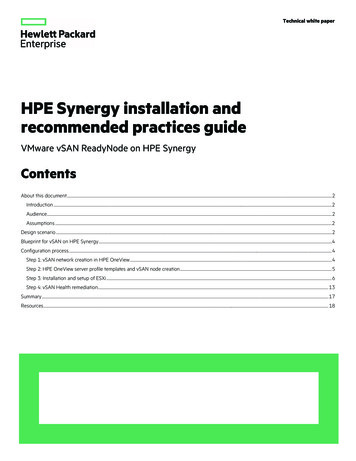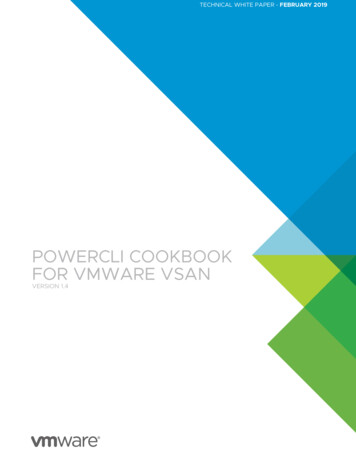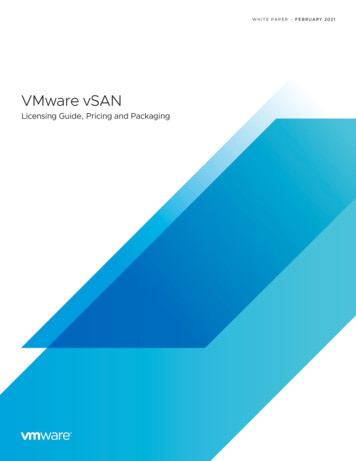
Transcription
WHITE PAPER – FEBRUARY 2021VMware vSANLicensing Guide, Pricing and Packaging
VMware vSAN 7.0 U2Table of ContentsIntroduction . 3Packaging Overview . 4Upgrades . 6Virtual Desktop Infrastructure . 7Remote Office / Branch Office . 72-node Architecture . 7VMware HCI Kits . 10Licensing Scenarios. 11Summary . 13WHITE PAPER 2
VMware vSAN 7.0 U2IntroductionHCI converges compute and storage resources on industry-standard x86 servers and uses software toabstract and pool cluster resources with unified management software. Hyperconverged infrastructuretransforms data centers by simplifying operations through automation, lowering TCO by leveragingindustry standard servers and scaling incrementally.VMware’s industry leading HCI software stack consists of vSphere for compute virtualization, vSAN,vSphere integrated storage, and vCenter for virtual infrastructure management. VMware HCI isconfigurable, and seamlessly integrates with VMware NSX to provide more secure networkvirtualization and/or vRealize Suite for advanced hybrid cloud management capabilities. HCI can beextended to the public cloud, as VMware powered HCI has integrated services with the six of thelargest cloud providers, Amazon, Microsoft, Google Cloud, Alibaba, Oracle and IBM. Hundreds ofpublic cloud providers also offer HCI-as-a-Service, including Rackspace, CenturyLink and OVH.VMware vSAN enables customers to prime their business for growth through seamless evolution,leading flexibility and hybrid cloud capabilities. vSAN helps customers seamlessly evolve, as it isintegrated to vSphere and requires no new tools. vSAN’s industry leading ecosystem empowerscustomers to run HCI on certified solutions with their preferred vendor, and hybrid cloud capabilitiesprovide customers consistent operations from edge to core to cloud, with intrinsic security throughout.VMware provides the broadest choice of consumption options for HCI including VxRail , a fullyintegrated HCI appliance from Dell EMC tailored for ease of deployment and over 500 pre-certifiedvSAN ReadyNodes from all major server vendors for complete flexibility in aligning with customer’svendor preferences and experiences. VMware also offers a fully managed infrastructure-as-a-serviceon-premises with VMware Cloud on Dell EMC; partners also offer infrastructure as-a-service, such asVMware Cloud Foundation on HPE Synergy with HPE GreenLake.vSAN Licensing OverviewVMware vSAN can be licensed on a per-CPU, per-concurrent user in 10 or 100 license packs for virtualdesktop infrastructure (VDI), and per-virtual machine in 25-VM license packs for remote office branchoffice (ROBO) implementations. Note that all editions can be licenses on these three metrics, exceptfor vSAN Enterprise Plus, which is only available on a per-CPU license. More details can be found hereon vSAN for VDI licensing and here on ROBO licensing.In March 2020, VMware also announced an update to the per-CPU licensing model. While VMware willstill be using a per-CPU approach, now, for any software offering that VMware license on a per-CPUbasis, VMware will require one license for up to 32 physical cores. If a CPU has more than 32 cores,additional CPU licenses will be required. Please see this FAQ for more details.WHITE PAPER 3
VMware vSAN 7.0 U2Packaging OverviewvSAN license editions include Standard, Advanced, Enterprise, and Enterprise Plus. The following tableshows the features included with each license orage Policy Based Mgmt. Virtual Distributed Switch Rack Awareness Software Checksum All-Flash Hardware iSCSI Target Service QoS - IOPS Limit Cloud Native Storage (CNS) ControlPlane vSphere Container StorageInterface (CSI) Driver Shared Witness Deduplication & Compression RAID-5/6 Erasure Coding vRealize Operations within vCenter Data-at-Rest and Data-In-TransitEncryptionStretched Cluster with Local FailureProtectionFile Services HCI Mesh1 Data Persistence Platform forModern Stateful Services EditionsvSAN 7 U2vRealize Operations 8 Advanced Table 1. License Editions and Product Features1 Cross Cluster Capacity SharingWHITE PAPER 4
VMware vSAN 7.0 U2Notes: The deduplication & compression and RAID-5/6 erasure coding features require an all-flash vSANconfiguration. These features are not supported with hybrid vSAN configurations. vSAN Standard, Advanced, Enterprise editions are licensed per-CPU (socket), per-VDI, or per-VM.Enterprise Plus edition is licensed per-CPU only. These four vSAN editions are available asstandalone licenses and are not included with VMware vSphere . Mixed workload—server anddesktop—should be run on a vSAN cluster with per CPU vSAN licensing. A vSphere host that is not contributing local storage to a vSAN datastore can be a member of thevSAN cluster and utilize the vSAN datastore. Even though a host is not contributing storage, thehost must be licensed for vSAN. Customers can upgrade license keys in My VMware portal by following the instructions posted onVMware Knowledge Base article on “How to upgrade license keys in My VMware”. Customers can downgrade license keys in My VMware portal by following the instructions postedon VMware Knowledge Base article on “How to downgrade license keys in My VMware”. Complete list of features contained in vSAN version is located on Storage Hub.vSAN 7.0 U2 introduced notable feature enhancements to HCI Mesh and File Services:HCI Mesh now allows vSAN clusters to share storage capacity with compute clusters, or non-HCIvSphere clusters. Customers can now adopt HCI without needing to replace existing servers, scalecompute and storage independently and precisely to meet application needs, and optimizeresource utilization across clusters, all while maintaining the operational simplicity of HCI.To license an HCI Mesh deployment for just vSAN clusters or for vSAN clusters sharing storagecapacity with compute clusters, vSAN Enterprise or Enterprise Plus licenses and any edition ofvSphere licenses are required for the vSAN cluster. vSphere licenses are required on the vSANcluster to maintain a unified HCI management control plane. Note that the compute clustersrequire vSphere licenses, but do not require vSAN licenses.File Services now simplifies backup of file shares with an API that will allow backup and recoverysoftware vendors to integrate with vSAN file services. This API will make the backup softwareaware of vSAN file shares, enabling them to track the new data created and only backup theincremental data created since the last backup. In addition, VMware has added scalabilityenhancements to files; customers can now enable file shares on 2-node vSAN deployments,making it a great option to replace low end NAS filers in ROBO settings.vSAN 7.0 U1 introduced 4 new features and feature enhancement on File Services:Data Persistence platform provides a framework for VMware partners that offer modern statefulservices, such as object storage and NoSQL databases, to integrate with the underlying virtualinfrastructure. The integration allows customers to run stateful services with high velocity scaling,simplified IT operations, and optimized TCO.Developers can provision and scale services on demand with Kubernetes API.Admins can rapidly deploy services and monitor the health and capacity of services from VMwarevCenter , while easily keeping the services up and running during infrastructure maintenance andupgrades.Customers can deploy a stateful service alongside traditional applications on a regular vSAN clusterwith vSAN-SNA (vSAN Support for Shared Nothing Architecture) policy, or deploy it on a dedicatedvSAN cluster with vSAN Direct Configuration , a technology enabling direct access to theunderlying direct-attached hardware which can be optimized for the application needs. Bothoptions benefit from optimal storage efficiency for modern stateful services by leveraging servicelevel replication, as well as unified management of services in vCenter.WHITE PAPER 5
VMware vSAN 7.0 U2Each partner must develop their own plug-in for VMware customers to receive the benefits ofvSAN Data Persistence platform. The platform is not operational until the partner solution runningon top is operational. vSphere Enterprise Plus, Tanzu Standard, and NSX-T Advanced or above arerequired to use the Data Persistence platform. Data Persistence platform is available in vSANEnterprise and Enterprise Plus only.HCI Mesh brings together multiple independent vSAN clusters for a native, cross-clusterarchitecture that disaggregates resources and enables utilization of stranded capacity. HCI Mesh isavailable with vSAN Enterprise and Enterprise Plus Editions.Data-In-Transit Encryption delivers over the wire encryption for data between the vSAN Nodesusing native encryption with vSAN and is simple to implement with no Key Management Server(KMS) required. Data-In-Transit Encryption is available in the Enterprise and Enterprise Pluseditions.Shared Witness enables multiple 2 Node vSAN deployments to share a common witness instance,with up to 64 clusters max per single shared witness host, reducing resources required for ROBOdeployments. Shared witness is available in all vSAN editions.File Services now supports the SMB protocols in addition to NFS protocols. vSAN File Services alsoadds critical capabilities that make it enterprise-ready, with Active Directory integration andKerberos support. File Services is only available in the Enterprise and Enterprise Plus editions.vSAN 7.0 introduced File Services. vSAN File Service is a layer that sits on top of vSAN to provide fileshares. It currently supports NFSv3 and NFSv4.1 file share. vSAN File Service comprises of vSANDistributed File System (vDFS) which provides the underlying scalable file system by aggregating vSANobjects, a Storage Services Platform which provides resilient file server end points and a control planefor deployment, management, and monitoring. File shares are integrated into the existing vSANStorage Policy Based Management, and on a per-share basis. vSAN File Service brings in capability tohost NFS file shares directly on the vSAN cluster.vSAN 6.7 U3 release includes 2 major changes in vSAN licensing model. vSAN added a 4th editionvSAN Enterprise Plus edition which is a hard bundle of vSAN ENT and vROps Advanced features. Thisrelease also added Cloud Native Storage (CNS) Control Plane and vSphere Container Storage (CSI)Driver features which are included in all the vSAN editions.vSAN 6.6 introduced vSAN data-at-rest encryption, which requires an external Key ManagementServer (referred as KMS) that provides the primary encryption key. This key is used to encrypt otherkeys in the cluster. While VMware does not provide a KMS solution, vSAN encryption is certified towork with enterprise grade key management servers. Please note, KMS vendors may have anadditional licensing requirement. Different KMS vendors offer different license options, please checkwith the KMS vendor for further details. For a list of certified KMS vendors, refer to the VMwarecompatibility guide.UpgradesCustomers that would like to upgrade an existing vSAN license edition to a higher edition to enableadditional functionality can purchase upgrades. For example, an organization that utilizes vSANAdvanced edition can purchase an upgrade to the Enterprise edition to enable a stretched clusterarchitecture. Consult with your preferred reseller to get the current list of available upgrades andpricing.Note: Availability, pricing, and packaging can change at any time without warning. It is always best toconsult with your preferred reseller to get current pricing and packaging options for any VMwaresolution.WHITE PAPER 6
VMware vSAN 7.0 U2Virtual Desktop InfrastructurevSAN for Desktop licensing is available for customers using vSAN exclusively for virtual desktopinfrastructure (VDI). This includes third-party VDI solutions in addition to VMware Horizon . While thislicense option limits the use of vSAN to VDI workloads only, vSAN for Desktop provides unique pricingand packaging options to help further reduce the cost of VDI while enabling the benefits andperformance of a distributed storage platform. vSAN for Desktop is available in Standard, Advanced,and Enterprise editions. It is priced per-concurrent user (CCU) in a virtual desktop environment andsold in packs of 10 and 100 licenses.vSAN Advanced CCU licenses are now included in the following Horizon Bundles: Horizon AdvancedTerm, Horizon Enterprise Term, and Horizon Universal. Note that vSAN Advanced CCU licenses arenot included in any of the Horizon perpetual bundles. More information on Horizon bundles can befound in this Horizon Subscription Feature Comparison and Horizon Perpetual and Term FeatureComparison.Remote Office / Branch OfficevSAN is an excellent solution for remote office and branch office (ROBO) implementations, asdescribed in this solution brief: VMware vSAN Remote Office/Branch Office Deployment. vSAN forROBO licenses are priced per-virtual machine (per-VM) and sold in packages of 25 licenses. A 25-packof licenses can be shared across multiple locations—for example, five remotes offices each running fivevirtual machines. This approach provides deployment flexibility and helps minimize the cost of smallerinfrastructures commonly found at remote offices.Each remote office is limited to a maximum of 25 virtual machines under the vSAN for ROBO licensingmodel. If more than 25 virtual machines are running at a remote office, vSAN Standard or Advanced, orEnterprise per CPU licensing must be used. Any number of hosts can be licensed with vSAN for ROBOStandard or Advanced or Enterprise as long as the number of virtual machines running on a vSANcluster at a single location is 25 or less.It is possible to start with vSAN for ROBO licenses and then switch to vSAN Standard, Advanced, orEnterprise per CPU licenses without disruption when a remote office grows beyond 25 virtualmachines. The definition of a remote office or branch office is any remote physical location other than aprimary data center. It is important to note there is no upgrade/conversion path from vSAN for ROBOper-VM licenses to vSAN Standard, Advanced, Enterprise, and Enterprise Plus per-CPU licenses.2-node ArchitectureAnother important item to discuss is the deployment of a 2-host architecture at the same location,which is supported and common in remote office implementations. A 2-host or “2-node” architectureconsists of two physical vSphere hosts in a cluster in the same building running vSAN. More details on2-node vSAN architecture can be found on storage hub. The example below shows a main data centerWHITE PAPER 7
VMware vSAN 7.0 U2and three remote offices. Each remote office has a 2-node vSAN cluster and a witness host for eachcluster runs at the main data center.Figure 1. vSAN ROBO DeploymentThe vSAN Witness Appliance is deployed from an OVA file and includes an embedded license. There isno need to purchase a vSphere license for the vSAN Witness Host when a vSAN Witness Applianceused. If the vSAN Witness host is a physical machine, a vSphere license for this host is required. Thediagram below shows the selection of the vSphere license for the witness host virtual appliance.Figure 2. vSAN Witness LicenseWhen Using vSphere Essentials BundlesvSphere Essentials Kit or vSphere Essentials Plus Kit licensing limits the number of hosts managed byvCenter Server Essentials to three. When using a physical host as the vSAN Witness Host, it is considered a host by the Essentialslicensing bundle. When using the vSAN Witness Appliance as the vSAN Witness Host, it is not considered a host bythe Essentials licensing bundle.o This is because virtual machine workloads are not supported nor allowed to run on the vSANWitness ApplianceHere is an example of a supported configuration: One physical host at the main data center managed by vCenter Server that is licensed withvCenter Server Essentials Two physical hosts at a remote office running a 2-node vSAN configuration managed by the samevCenter Server The vSAN Witness Appliance deployed at the main data center is used as a vSAN Witness Hostfor the 2-node vSAN configuration The vSAN Witness Appliance must be added to vCenter prior to the 3 rd physical host being addedto vCenterWHITE PAPER 8
VMware vSAN 7.0 U2 A warning message will be generated when attempting to add the vSAN Witness Appliance as avSAN Witness Host after the 3 physical hosts have been addedNote: The order of operation is important – vCenter does not recognize the vSAN Witness Applianceas a virtual host until after it is added to vCenterStretched Cluster with Local Failure ProtectionThe Stretched Cluster feature with local failure protection is available with the Enterprise andEnterprise Plus editions of vSAN. More details on 2-node vSAN architecture can be found on StorageHub.vSAN Stretched Cluster feature in vSAN Enterprise for ROBO is allowed for the below configurations: Stretched Cluster within a ROBO site may be used when no more than 25 total powered on VMsare running on the vSAN Stretched Cluster. Stretched Cluster across 2 ROBO sites may be used when no more than 25 total powered on VMsare running across the 2 ROBO sites and ensure that in case of a site failure, the surviving ROBOsite will have no more than 25 total powered on VMs.vSAN Stretched Cluster feature in vSAN Enterprise for ROBO is not allowed for the belowconfigurations: Stretched Cluster configuration may not be stretched between a ROBO site and a site such as aprimary data center. This scenario would require a traditional vSAN Enterprise license. MixingROBO and per CPU traditional licensing is not possible because:a. A ROBO license may not be used in a site that is not categorized as ROBO. Stretching a vSANCluster using a ROBO license might lead to ROBO licensed VMs migrating to non-ROBO sitewhich is not compliantb. A vSAN cluster may not use mixed licensing because a single vSAN license is applied to eachvSAN cluster. Stretching between Datacenter and ROBO site would require mixing per CPUlicenses in the datacenter with per VM licenses in the ROBO siteTherefore, it is recommended that customers use traditional per-CPU vSAN Enterprise licensing forthis scenario.WHITE PAPER 9
VMware vSAN 7.0 U2VMware HCI KitsNew licensing and packaging options were introduced with vSAN. VMware HCI Kit bundles simplify thepurchase of vSphere and vSAN licenses. There are five data center kits with per-CPU licensing and tworemote office branch office kits with per-VM licensing: VMware HCI Kit Essentials (per-6 CPUs) that includes vSphere Essentials plus and vSAN Standard VMware HCI Kit Standard (per-CPU) that includes vSphere Standard and vSAN Standard VMware HCI Kit Advanced (per-CPU) that includes vSphere Enterprise Plus and vSAN Advanced VMware HCI Kit Enterprise (per-CPU) that includes vSphere Enterprise Plus and vSAN Enterprise VMware HCI Kit with Operations Management (per-CPU) that includes vSphere Enterprise Plusand vSAN Enterprise Plus VMware HCI Kit ROBO Standard (per-25 VMs) that includes vSphere ROBO Enterprise and vSANROBO Standard VMware HCI Kit ROBO Advanced (per-25 VMs) that includes vSphere ROBO Enterprise and vSANROBO AdvancedNote: A maximum of one ROBO pack can be deployed per remote office site. A ROBO license packcan be split across sites—for example, five remote office sites with five virtual machines each wouldrequire only one ROBO license pack. HCI kit Essentials is the only HCI kit which comes with vCenterEssentials (vSphere Essentials Plus kit contains vCenter Essentials).WHITE PAPER 10
VMware vSAN 7.0 U2Licensing ScenariosThis section contains several example vSAN implementation scenarios and vSAN licensing for thesescenarios. All scenarios utilize hosts that have two populated CPU sockets and CPUs with less than 32physical cores unless otherwise noted.Scenario 1: 16-host all-flash vSAN cluster for server workloads requiring data-at-rest encryption.32 vSAN Enterprise licenses are needed. Data-at-rest encryption is a feature included only in theEnterprise edition of vSAN.Scenario 2: 8-host all-flash vSAN cluster virtual desktops with 180 concurrent users.vSAN for Desktop Advanced or Enterprise licenses (two CCU 100-packs) would likely be the bestchoice although it is possible to license this cluster with vSAN for Desktop Standard licenses. Standardlicense editions also support the use of all-flash hardware. However, Advanced and Enterprise licensesenable the use of deduplication, compression, and erasure coding. These vSAN space efficiencyfeatures typically provide a considerable reduction in the cost per usable gigabyte of capacity.Scenario 3: 20-host hybrid vSAN configuration running a combination of desktop workloads and serverworkloads other than the servers supporting virtual desktops in a primary data center.40 vSAN Standard per-CPU licenses are required to properly license this cluster. Even though thereare some virtual desktops running in this cluster, vSAN for Desktop licensing cannot be used, as thereare also non-desktop workloads present.Note: While it is possible to mix server and virtual desktop workloads in a vSAN cluster, VMwarerecommends a dedicated cluster for larger virtual desktop deployments.Scenario 4: 2-host all-flash vSAN cluster running 10 virtual machines in a remote office.There are less than 25 virtual machines running at this office, which means vSAN for ROBO Standardlicenses can be used. vSAN for ROBO Advanced licenses would enable deduplication, compression,and erasure coding features. vSAN for ROBO Enterprise licenses would enable data at rest encryptionand stretched cluster with local failure protection features.Scenario 5: 3-host all-flash vSAN cluster at a remote office running 30 virtual machines.vSAN for ROBO licenses cannot be used in this scenario because the number of virtual machines ismore than 25. Six vSAN Standard per-CPU licenses are needed as there are three hosts each with twoCPUs. vSAN Advanced licenses would enable deduplication, compression, and erasure coding sincethis is an all-flash configuration. However, a minimum of four hosts are required for erasure coding.Scenario 6: Three remotes offices each with a 2-host hybrid vSAN cluster. The first remote office isrunning 10 virtual machines. The second remote office is running 12 virtual machines. The third remoteoffice is running 28 virtual machines.A 25-pack of vSAN for ROBO Standard licenses would cover the first and second remote offices. Thethird remote office would require four vSAN Standard licenses as there are more than 25 virtualmachines running at this location.Scenario 7: Remote office licensed with vSAN for ROBO Standard (per-VM 25-pack) originally running20 server VMs on three physical hosts. The number of VMs has grown to 30.vSAN for ROBO licenses enable up to 25 VMs to be licensed at a single remote office location. In thisscenario, the number of VMs at the remote office has grown beyond the 25 VMs limit. The vSAN forROBO licenses must be replaced with per-CPU licenses (vSAN Standard, Advanced, or Enterprise).There is no upgrade path or conversion from vSAN for ROBO to vSAN per-CPU licenses. The vSAN forROBO licenses can be repurposed for another remote office location with 25 VMs or less.WHITE PAPER 11
VMware vSAN 7.0 U2Scenario 8: 12-host vSAN stretched cluster with six hosts at a primary location and six hosts at asecondary location. A vSAN witness host (virtual appliance) is deployed at a third location.This scenario requires 24 vSAN Enterprise per-CPU licenses. The witness virtual appliance includes avSAN license.Scenario 9: 1 host 1 host witness (2-node cluster) across 3 rooms in the same building with maximum25 VMsThis scenario requires either 1 vSAN STD for ROBO (per-VM 25-pack) or 4 vSAN STD per CPU licenses.Scenario 10: 1 host 1 host witness (2-node cluster) across physical sites with maximum 25 VMsThis scenario requires either 1 vSAN STD for ROBO (per-VM 25-pack) or 4 vSAN STD per CPU licenses.Customer does not require ENT licenses for a 2-node cluster stretched across 2 physical site.Scenario 11: 3 host 3 host witness (stretched cluster) across 3 rooms in the same building withmaximum 25 VMsThis scenario requires either 1 vSAN ENT for ROBO (per-VM 25-pack) or 12 vSAN ENT per CPUlicenses. Stretched cluster feature is only available in ENT edition of vSAN. Learn more about the vSANStretched Cluster feature in vSAN ENT for ROBO in the Stretched Cluster section of the guide.Scenario 12: 3 host 3 host witness (stretched cluster) across physical sites with maximum 25 VMsThis scenario requires either 1 vSAN ENT for ROBO (per-VM 25-pack) or 12 vSAN ENT per CPUlicenses. Stretched Cluster feature is only available in ENT edition of vSAN. Learn more about thevSAN Stretched Cluster feature in vSAN ENT for ROBO in the Stretched Cluster section of the guide.WHITE PAPER 12
VMware vSAN 7.0 U2Summary vSAN works with any edition of vSphere (Main editions, Acceleration Kit, Essentials Kits, ScaleOut, ROBO, Desktop)vSAN Standard, Advanced, Enterprise, and Enterprise Plus licenses are per-CPU (socket)licenses. All hosts in the cluster must be licensed.All-flash vSAN configurations are supported with the Standard license. Deduplication,compression, and erasure coding require Advanced, Enterprise, or Enterprise Plus licenses.Stretched cluster configurations and data-at-rest encryption require Enterprise and EnterprisePlus licenses.vSphere and vSphere with Operations Management licenses do not include vSAN.vSAN for Desktop are concurrent user (CCU) licenses available in a pack of 10 and 100.vSAN for ROBO are per-VM licenses available in a pack of 25.vSAN for ROBO licenses can be spread across multiple remote offices.Only one vSAN for ROBO Standard or Advanced 25-pack of licenses can be used at a remoteoffice. Running more than 25 virtual machines at a single remote office location disqualifies theuse of vSAN for ROBO licensing at that location.vSAN for Desktop licenses can only be used to run virtual desktop workloads.vSAN Advanced CCU licenses is no longer a part of Horizon Bundles after Horizon 8 releaseA 2-host vSAN cluster with a witness host can be deployed with any license edition.Any cluster with three or more physical hosts plus a witness host is a stretched cluster, whichrequires vSAN Enterprise or Enterprise Plus licensing.WHITE PAPER 13
VMware, Inc. 3401 Hillview Avenue Palo Alto CA 94304 USA Tel 877-486-9273 Fax 650-427-5001 www.vmware.com.Copyright 2020 VMware, Inc. All rights reserved. This product is protected by U.S. and international copyright and intellectual property laws. VMware products are covered by one or more patentslisted at vmware.com/go/patents. VMware is a registered trademark or trademark of VMware, Inc. and its subsidiaries in the United States and other jurisdictions. All other marks and names mentionedherein may be trademarks of their respective companies. Item No: vmw-wp-temp-word-104-proof 5/19
In March 2020, VMware also announced an update to the per-CPU licensing model. While VMware will still be using a per-CPU approach, now, for any software offering that VMware license on a per-CPU basis, VMware will require one license for up to 32 physical cores. If a CPU has more than 32 cores, additional CPU licenses will be required.
